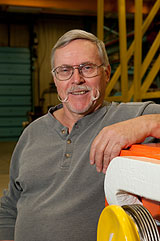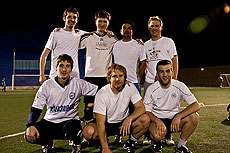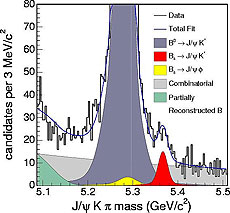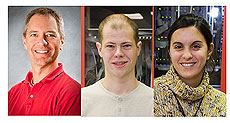|
Have a safe day!
Thursday, April 28
2 p.m.
LHC Physics Center Topic of the Week Seminar - Sunrise, WH11NE
Speaker: Michael Albrow, Fermilab
Title: Diffraction and Exclusive Interactions (Including Exclusive Higgs) – Part 1
2:30 p.m.
Theoretical Physics Seminar - Curia II
Speaker: Chiu Man Ho, Vanderbilt University
Title: Non-Static Extra Dimensions
3:30 p.m.
DIRECTOR'S COFFEE BREAK - 2nd Flr X-Over
THERE WILL BE NO ACCELERATOR PHYSICS AND TECHNOLOGY SEMINAR TODAY
Friday, April 29
2 p.m.
LHC Physics Center Topic of the Week Seminar - Sunrise, WH11NE
Speaker: Michael Albrow, Fermilab
Title: Diffraction and Exclusive Interactions (Including Exclusive Higgs) – Part 2
3:30 p.m.
DIRECTOR'S COFFEE BREAK - 2nd Flr X-Over
4 p.m.
Joint Experimental-Theoretical Physics Seminar - One West
Speaker: Yasuhiro Nakajima, Kyoto University/Lawrence Berkeley National Laboratory
Title: Search for Neutrino Disappearance with SciBooNE and MiniBooNE
Click here for NALCAL,
a weekly calendar with links to additional information.
Upcoming conferences
|
|
Thursday, April 28
- Breakfast: Apple sticks
- Tomato Florentine
- BBQ pork sandwich
- *Kielbasa & sauerkraut
- *Chicken Marsala
- Smoked turkey melt
- Assorted sliced pizza
- Southwest chicken salad w/ roasted corn salsa
*Heart healthy choice
Wilson Hall Cafe Menu
|
|
Friday, April 29
Dinner
- Caribbean grilled scallop salad
- Orange-glazed pork medallions
- Spiced celery pilaf
- Cinnamon phylo nest w/ caramelized pears
Chez Leon Menu
Call x3524 to make your reservation.
|
|
Bob Jensen, magnet maker, retires Friday
 |
|
Bob Jensen at Industrial Building 2.
Photo: Reidar Hahn |
Bob Jensen has built nearly every type of magnet used in Fermilab’s accelerators. But the senior operations specialist will soon have time to focus on a different type of handiwork. He retires Friday after more than 42 years.
Jensen, who sports a handlebar mustache and a hearty laugh, said the things he’ll remember most about Fermilab are his colleagues and always being challenged. He’ll also miss the laboratory’s can-do culture, which he said has existed from the beginning.
“One sweltering summer night I was working late in Lab 6 to finish a Booster magnet. Robert Wilson walked in and he knew me by name,” Jensen said. “I had never met him.”
Jensen, who has ID number 315, joined the laboratory in November 1968 after time in the Navy. Jensen worked the lab's official groundbreaking, and then spent his early days as a lab assistant learning how to build magnets for various accelerators. During his career, Jensen has built and worked on magnets for the Main Ring, Booster, Recycler, Meson and Tevatron, among others.
“There have been quite a few different magnets that I’ve put my hands on or built,” Jensen said. “We must have done something right for the magnets to run this well for so long.”
Because of his expertise, Jensen was eventually asked to work on travelers – documents that travel with the magnets and contain necessary information for building them and assessing their quality.
Jamie Blowers, Jensen’s manager in the Technical Division’s Quality & Materials Department for about 10 years, said Jensen is a great employee who will be extraordinarily missed.
“He’s been all over the laboratory and knows a lot about what worked and what didn’t,” Blowers said. “A lot will be lost when he leaves. We’ll adapt, but we won’t be able to fill his shoes.”
Read more
— Rhianna Wisniewski
|
Leadership changes at URA
The URA Board of Trustees, in its meeting on April 12, elected Dr. Steven Beering to the newly created position of executive chair of the Board of Trustees, succeeding long-time Chair Joe Wyatt. Dr. John H. Marburger, III, vice president for research at Stony Brook University, and formerly adviser to the President for Science and Technology and director of the Office of Science and Technology Policy (OSTP), was elected vice chair of the board, and Dr. Marta Cehelsky was appointed URA executive director.
Dr. Beering, a member of the URA Board of Trustees since 1997, is president emeritus of Purdue University. As URA Board executive chairman he will also serve as vice chairman of the Board of Directors of Fermi Research Alliance, LLC (FRA), under which URA and the University of Chicago jointly manage and operate Fermilab under the current Department of Energy contract. In his new position, Dr. Beering succeeds Fred Bernthal, former president of URA, as vice chair of the FRA Board.
Read more
|
Soccer champs
 |
| Members of "Fermilab Deportivo", a soccer team, pose for a photo after winning the Windy City Wanderers Football Club tournament in Chicago on April 12. Pictured: Alexander Dzyuba, TD; Alexander Romanenko, TD; Donato Passarelli, TD; Guillermo Fernandez Moroni, PPD; Christian Graf, DZero; Alfonso Castillo, BSS; and Alexey Naumov, TD. Photo: Alexey Naumov |
|
The AMS detector heads for the International Space Station
From InterActions.org, April 27, 2011
Geneva 27 April 2011. The AMS particle detector will take off on 29 April 2011 at 21.47 CEST onboard the very last mission of the space Shuttle Endeavour. AMS, the Alpha Magnetic Spectrometer, will then be installed on the International Space Station from where it will explore the Universe for a period of over 10 years. AMS will address some of the most exciting mysteries of modern physics, looking for antimatter and dark matter in space, phenomena that have remained elusive up to now.
In laboratories like CERN, physicists observe matter and antimatter behaving in an almost identical way. Each matter particle has an equivalent antiparticle, very similar but with opposite charge. When particles of matter and antimatter meet, they annihilate. Matter and antimatter would have been created in equal amounts at the Big Bang, yet today we live in a Universe apparently made entirely of matter.
Read more
|
House science committee comments on administration FY 2012 S&T budget request
From FYI: AIP Bulletin of Science Policy News, April 26, 2011
When Congress returns next week one of the major items on its agenda will be the initial drafting of the FY 2012 appropriations bills. The House and Senate authorization and appropriations committees have held hearings to review the FY 2012 request, with other hearings to be scheduled. Information on the Administration’s budget request and on selected S&T hearings is available.
Last month the Republicans on the House Science, Space, and Technology Committee released a report that highlights areas of agreement and disagreement with the Administration’s FY 2012 requests for agencies under the committee’s jurisdiction. Intended to guide the House Budget Committee in its preparation of the FY 2012 Budget Resolution that was adopted by the House on April 15, this document will also inform the appropriators.
Read more
|
|
New ways to decay
 |
|
This plot shows one of the new ways for B0s
mesons to decay. The decay appears on this mass plot as the red bump (J/ψ K-Star).
|
Particles can be rather particular about how they choose to decay. Though some particles may have hundreds of choices available to them, these particles typically have just a few ways that they prefer over all others. Despite having such strong preferences, particles do occasionally decay in one of their less preferred ways.
CDF scientists have recently studied this process for the B0s meson. Recently, we have looked at 5.9 inverse femtobarns of data and have identified two new ways in which the B0s meson can decay. Given that this is not the preferred decay chain, this type of discovery is only possible with the large data samples now available that allow us to look for these rare decay modes.
Before anyone can claim a discovery or in this case, an observation of one of these rare decay modes, they have to demonstrate that they are able to make physics measurements of objects that physicists have seen and obtain answers comparable to that knowledge. Only then will the particle physics community acknowledge this rare finding as being plausible. For this analysis, a common particle that physicists can use as a benchmark and is quite similar to the B0s is the B0 meson. One of the decay modes for the B0 is into particles called the J/ψ and the K-Star meson, while a second decay mode is the J/ψ and K-short meson. These two decay modes from this B0 particle are identical to the decay modes of the B0s particle that we are interested in. The B0 thus makes an ideal test subject.
The figures show very large peaks at a mass of 5.28 GeV/c2, which is the decay of the B0. This meson has been measured precisely by a number of experiments and was one of our test subjects. The small red peaks in the figure above at 5.36 GeV/c2 represent about 150 events in one of these newly observed rare decay modes. (A second figure shows 65 events.) Each of these new decay modes is rather rare— less than 1 in every 50,000 B0s mesons will decay in these newly identified ways.
Scientists can now investigate the properties of these newly identified objects to see if they behave the way we expect them to. These investigations will help us better understand the weak force and thus the world we live in. Learn more.
— Edited by Andrew Beretvas
 |
|
Individuals involved in this analysis include: From left, Kevin Pitts, Ben Carls, Olga Norniella (all from the University of Illinois).
|
|
|
April 25-27
- Three stores provided ~39.25 hours of luminosity
- Pbar personnel repaired an LCW leak in Transport
- Linac personnel brought the I- Source online
- Linac RF tank #2 lost its vacuum due to a bad pickup ceramic
- Tevatron personnel conducted PIXEL detector studies
- Pbar personnel traced emittance blowups to dampers
- A1 beam transfer line suffered vacuum burst
- Operators filled MI kickers with Fluorinert
Read the Current Accelerator Update
Read the Early Bird Report
View the Tevatron Luminosity Charts
|
|